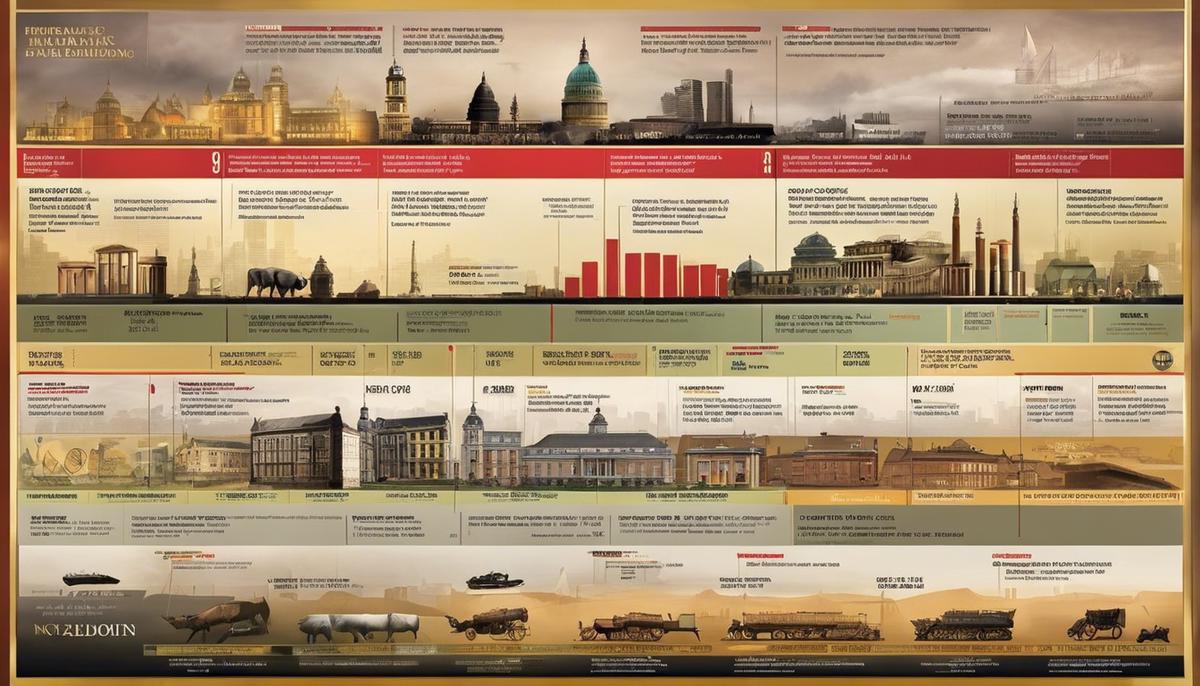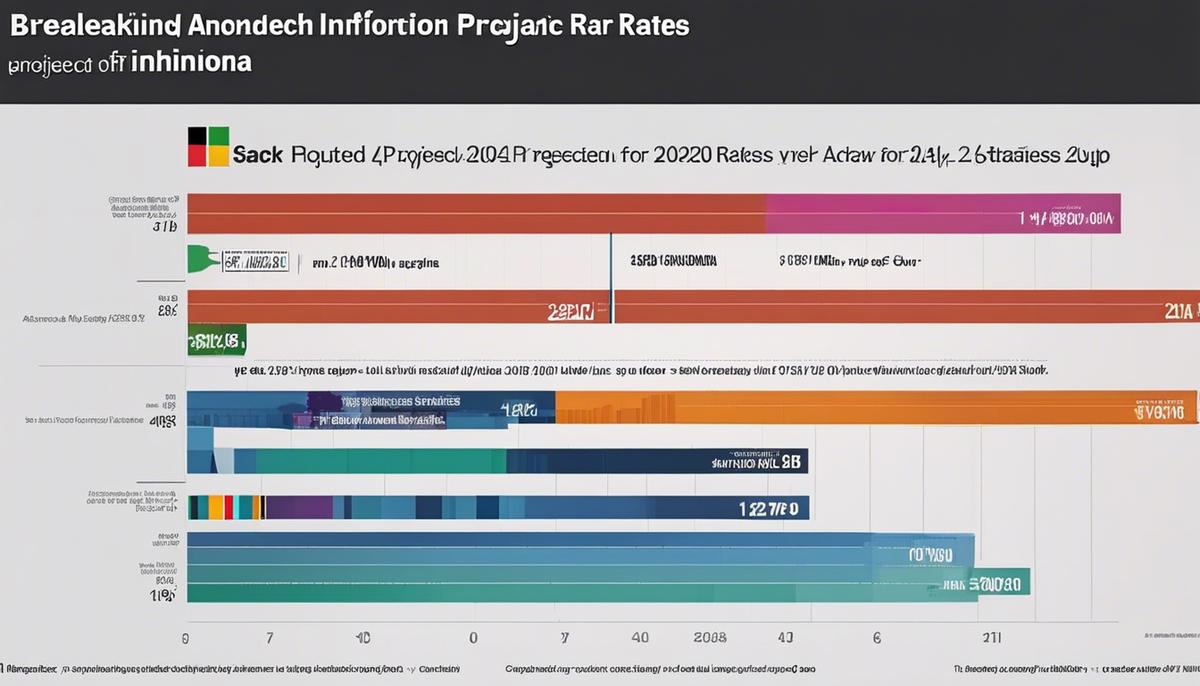Understanding Inflation Effects on IRA 2024
In our constantly evolving economic landscape, understanding key financial concepts such as inflation and its influence on significant investment vehicles, like the Individual Retirement Account (IRA), is vital to safeguarding individual financial prosperity. This examination unfolds complex economic rudiments into easily understandable elements, exploring the dynamics of inflation, its historical trends, and its potential impact on IRAs with a special focus on the year 2024. By peeling back the layers of cost-push and demand-pull inflation, assessing historical patterns, and gleaning insights from future economic indicators, we aim to forecast the probable state of inflation in 2024 and its subsequent implications on IRAs.
Inflation Basics
Inflation, an economic phenomenon often discussed with a sense of urgency and complexity, is a key determinant in shaping the contours of entire economies. It is essential to comprehend the operational mechanisms and implications of inflation to navigate the landscape of personal finance, economic policy, and investment dynamics effectively.
At its core, inflation refers to the rate at which the general level of prices for goods and services is rising. As this rate accelerates, purchasing power—a measure of the quantity and quality of goods and services one’s income can buy—correspondingly diminishes. Therefore, if inflation accelerates rapidly, a dollar tomorrow could buy less than a dollar could today.
Inflation is measured annually using indices, such as the Consumer Price Index (CPI) or the Producer Price Index (PPI). These indices survey and average the price of a basket of representative goods and services over time, thereby providing a gauge of buying power deterioration.
But what triggers inflation in the first place? There are two primary types of inflation: Cost-Push and Demand-Pull. Cost-Push inflation originates from increased production costs leading to higher-priced goods and services. These costs might incorporate higher wage demands from workers, increased raw-material prices, or changes in taxation.
On the other hand, Demand-Pull inflation transpires when the demand for goods and services surpasses their supply in the economy. Often a byproduct of robust economic growth, this heightened demand allows businesses to raise prices. The increased prices, coupled with robust demand, results in an elevated level of inflation in the long run.
It is essential, however, to highlight that moderate inflation is not inherently detrimental. A controlled rate of inflation is often indicative of a healthy, expanding economy. Central banks, such as the Federal Reserve in the United States, even aim for a deliberate annual inflation benchmark of about 2% to stimulate economic growth and discourage detrimental deflation.
Managing inflation is pivotal to economic stability and is usually under the purview of central banks through monetary policy. They primarily use tools—such as interest rates, open market operations, and reserve requirements—to manipulate money supply and, consequently, inflation. A delicate balance is paramount here. Too much inflation could erode purchasing power, while too little could lead to deflation, stagnating economic growth.
In conclusion, understanding inflation and its integral role in economic landscapes is undoubtedly crucial for individuals and policymakers alike. It determines purchasing power, influences economic policy, and impacts investment decisions, making it a compelling area of study and observation. Through the lens of expertise, the complexities of inflation are intriguing and pivotal, warranting continual examination and comprehension.

Inflation and its Historical Trends
Traversing the Landscape of Inflation: An Evolutionary Perspective and Unraveling of Patterns
Elegant in its simplicity yet profound in its impact, inflation has danced through the annals of economic history, leaving indelible footprints. Through a careful deciphering of these footprints, we might uncover patterns, predicting future steps the inflation dance might take. This article aims to lay bare the historical evolution of inflation, serving to spotlight the inherent cyclical patterns and trends that inextricably tie it to the economic realities of the present.
To venture into the labyrinth of inflation’s past, one must depart from the calm waters of gold-standard stability towards the tumultuous seas of the post-gold standard era. By the early 1970s, development economist and Nobel laureate, Gunnar Myrdal, had already rejected the naive belief that economies inevitably revert to a state of equilibrium. The ‘limits to growth’ theory, backed by sobering statistics, began to hint at the future trajectory of inflation, taking economists on a journey where wild fluctuations became the norm instead.
Historical records provide a chronicle of this journey, marching through periods of stagflation, hyperinflation, and deflation. Stagflation, a perplexing vortex of stagnation and inflation, emerged during the 1970s oil crisis, questioning traditional understanding. The 1980s saw hyperinflation rear its ugly head in economies like Brazil and Zimbabwe, creating a laboratory for economists to dissect the anatomy of spiraling price levels. Fast forward to the early 2000s, and the pendulum swung towards deflation, with countries like Japan serving as stark reminders of the perils of persistent falling prices.
The common thread weaving through the documented tapestry of inflation’s journey lies in the boom-bust cycle’s intermittent rhythm. Prices boiled over during economic booms, subsequently simmering down due to tightening monetary policies or economic slowdowns, revealing an intriguing pattern – that of being linked to the general economic health of an economy and its cyclical phases.
Furthermore, the prevalent ‘inflation-targeting’ approach of central banks, initiated in the early 1990s, has had substantial influence over inflation’s trajectory. As this approach became commonplace, so too did a certain predictability of inflation, as central banks aimed diligently for their set targets.
However, like the mystery of the cosmos, the universe of inflation is not without its anomalies. The technological boom and the burgeoning e-commerce industry have exerted disproportionate downward pressure on prices, in contradiction to standard economic indices predictions. This invites us to question our understanding and engage with inflation’s multilayered truth more deeply.
Inflation’s historical evolution constitutes more than just a chronicle of gyrating price levels. The orchestra of inflation, with its symphony of stagflation, hyperinflation, and deflation, serves as a vivid reflection of the economic zeitgeist of periods gone by. Understanding the cyclical patterns and acknowledging the anomalies will not only enrich the wider understanding of economic history but also facilitate a sneak peek into the potential future, shaping it for the better for the generations to come. Remember: while we may tread the dancing footprints of inflation, we are indeed the ones who dictate its music.

Mechanics of Individual Retirement Account (IRA)
Exploring Individual Retirement Accounts
An Individual Retirement Account (IRA) is a quintessential financial instrument present in the fabric of the American retirement landscape. An IRA is a tax-advantaged account that offers individuals the ability to save for retirement in the United States. Created in 1974, IRAs have since evolved, offering various iterations to meet a variety of financial circumstances and fit an individual’s retirement plan.
Types of Individual Retirement Accounts
There are three significant types of Individual Retirement Accounts: Traditional IRA, Roth IRA, and Rollover IRA, each with unique features aptly suited to individual requirements.
- Traditional IRA: allows individuals to make contributions with pre-tax dollars, thus potentially lowering their income tax liability during the years of contribution. These contributions and their subsequent earnings grow in a tax-deferred environment and are only taxed upon withdrawal, generally post-retirement.
- Roth IRA: offers a unique advantage where contributions are made using taxed income, allowing for tax-free withdrawals during retirement. The tax-free withdrawals also extend to the earnings generated within the account, offering the holders a significant advantage during their retirement years.
- Rollover IRA: becomes topically relevant in situations where individuals change jobs and intend to move their retirement savings from a previous employer’s plan, like a 401(k), into an IRA. This type of IRA helps individuals consolidate their retirement funds and maintain the tax advantages associated with these funds.
Functioning of Individual Retirement Accounts
The operation of an IRA necessitates the requirement of a custodian, typically a myriad spectrum of financial institutions, ranging from banks to robo-advisories. The custodian manages the account, complies with the pertinent tax laws, and reports to both the individual and the Internal Revenue Service (IRS).
Contributions and withdrawals within an IRA are governed by specific IRS rules. Annually, individuals can contribute up to an IRS determined limit. This limit adjusts periodically to accommodate cost of living considerations.
Withdrawing from an IRA before the age of 59 1/2 usually prompts a 10% early withdrawal penalty. However, there are exceptions for certain situations like purchasing a first home or specific higher education expenses.
Investments within an IRA can span a diverse portfolio including stocks, bonds, mutual funds, exchange-traded funds (ETFs), and Certificate of Deposits (CDs). The custodian generally dictates the available investment options.
The potential value of an IRA can reach significant heights due to the power of compound interest, from the tax-advantaged status, the potential for returns from the chosen investments, and the cumulative impact of reinvesting these earnings.
All told, IRAs play a pivotal role in shaping the retirement savings strategy of individuals, offering flexibility, tax benefits, and potent growth potential, paramount in a world grappling with inflationary pressures and economic uncertainty. Recognizing the immeasurable value IRAs offer is a vital step in planning for a secure and comfortable retirement.

Projected Inflation rates for 2024
Naturally, the discussion that defines, explains, and measures inflation via indices, or that delves into its subtypes and repercussions on economic stability and individual decision-making processes, took the discussion to the central point of this discourse: the factual forecast of inflation for the year 2024.
When interrogating the projected inflation figures for 2024, noteworthy forecasting models are employed. These consist of autoregressive models, vector auto regression models, and structurally adaptive models. These methods incorporate historical inflation data and also consider various economic indicators such as unemployment rates, GDP growth, and money supply among others.
Economic entities such as the International Monetary Fund (IMF), World Bank, and central banks of different countries carry out these forecasts. Each has both unique and overlapping methodologies to project inflation rates. These methods, combined with their deep-rooted expertise and extensive databases, enhance the authenticity and reliability of their projections.
The IMF, in its World Economic Outlook report, predicts a global inflation rate of around 3.5% for 2024. However, this estimate can and will fluctuate based on both global and national economic events that directly affect inflation.
For the United States, the Federal Reserve expects a Local Inflation rate of approximately 2.2% for 2024. This prediction is based on the Fed’s dual mandate from Congress, i.e., maximum employment and price stability, resulting in an inflation target of 2%.
However, it’s significant to comprehend that these forecasted figures are based on the assumption that there will be no drastic changes in oil prices, no major wars, or unexpected inflationary shocks, among other factors. It’s also crucial to understand that while these projections provide a guiding expectation, they are by no means set in stone.
Looking at these predictions from the perspective of retirement savings and Individual Retirement Accounts (IRAs), there are a few crucial points of consideration for individuals. Firstly, a moderate inflation rate is important in ensuring that interest rates, and by extension, investment returns stay positive. Secondly, IRAs, due to their long-term nature, need to take into account projected inflation rates to maintain purchasing power and not erode the value of retirement savings.
In conclusion, understanding the future trajectory of inflation through forecasted figures equips individuals and policymakers with vital information for strategic planning. Although the year 2024’s precise inflation rates remain uncertain and subject to various influences, these forecasts serve as essential compasses in navigating financial decision-making.

Impact of Projected Inflation on IRA in 2024
Projection and Anticipation: The 2024 Inflation Rates and their Effects on Individual Retirement Accounts (IRAs)
With an understanding of what inflation is, how it is measured, its manifestations, and the functions and types of IRAs, it becomes crucial to evaluate the potential influence of future inflation on these retirement accounts. In the realm of financial forecasting, economists utilize specified models to anticipate inflation trends. Such forecasting takes into account various factors, such as economic indicators, fiscal and monetary policies, and global economic conditions. Consequently, the inflation forecast for 2024 serves to illustrate potential future economic conditions.
At an international level, the International Monetary Fund (IMF) projects inflation rates. Conversely, for the United States, the Federal Reserve – functioning as the central bank – formulates local predictions. These forecasts are not only essential for economists and policymakers but also individuals planning for retirement and other financial milestones. Even subtle fluctuations in inflation rates can significantly influence the value of retirement savings, particularly in accounts like IRAs.
In the context of IRAs, a rising inflation forecast may have dual implications, affecting both contributions and withdrawals. An increase in the cost of living could prompt the Internal Revenue Service (IRS) to adjust the maximum contribution limits to these accounts, enabling individuals to set aside more for retirement.
For those nearing retirement or currently making withdrawals, a higher inflation rate may mean that the purchasing power of this income declines over time. This could manifest in a complicated scenario where retirees may be forced to withdraw more funds to sustain their lifestyles, potentially depleting their IRAs sooner than anticipated.
On the investment front, the predictive nature of inflation forecasts can serve as a beneficial tool. Anticipating higher inflation, investors might lean towards assets with higher returns to offset inflation-induced losses. For instance, an investor could opt for stocks over bonds, as the latter are typically fixed-income investments more susceptible to inflation’s erosive effects.
As such, inflation forecasts should not be viewed in isolation, but rather integrated into one’s overall financial strategy. It is through a pro-active approach, combining awareness, planning, and adaptation, that individuals can harness inflation forecasts effectively and protect their retirement savings. Thus, while navigating the tides of financial turbulence might seem daunting, an understanding of inflation, in conjunction with strategic planning, can ensure that your IRA survives and thrives, even in an inflationary storm.
In essence, the projected inflation rate for 2024 – and indeed any other year – holds significant implications for IRAs and by extension, retirement planning. While these forecasts are not certainties, they provide invaluable guidance for individuals looking to strengthen their financial futures. Therefore, understanding, anticipating, and harnessing these forecasts should be seen as integral parts of any sensible, future-minded financial strategy.

Photo by neonbrand on Unsplash
As we trace the anticipated trajectory of inflation leading into 2024, it becomes apparent that thorough comprehension of its implications is key to secure, resilient long-term financial planning, particularly in relation to Individual Retirement Accounts. Harnessing a broad understanding of economic theories, historical precedents, and future indicators, we can equip ourselves with the knowledge needed to navigate potential challenges and take advantage of possible opportunities. Armed with this wisdom, investors can deploy effective strategies to mitigate the negative impact of inflation, ensuring their IRAs aren’t just preserved, but continue to grow, enabling a comfortable and financially secure retirement.



Leave a Reply